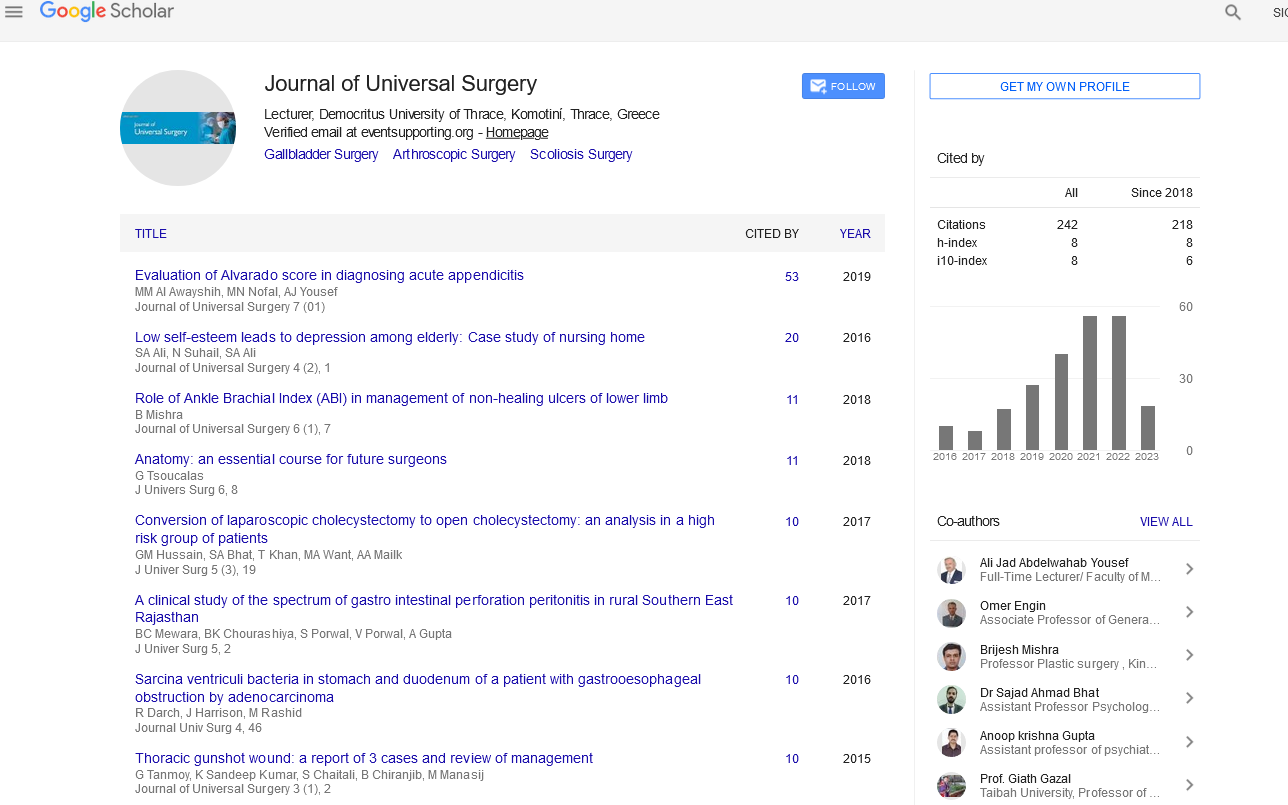Perspective - (2024) Volume 12, Issue 3
Placebo for Fibroid Treatment before Surgery
Rikki Rosie*
Department of Gynecology, Unversity of Nosara, Nosara, Costa Rica
*Correspondence:
Rikki Rosie, Department of Gynecology, Unversity of Nosara, Nosara,
Costa Rica,
Email:
Received: 15-May-2024, Manuscript No. IPJUS-24-14866;
Editor assigned: 20-May-2024, Pre QC No. IPJUS-24-14866 (PQ);
Reviewed: 03-Jun-2024, QC No. IPJUS-24-14866;
Revised: 24-Jun-2024, Manuscript No. IPJUS-24-14866 (R);
Published:
27-Jun-2024
Introduction
Uterine leiomyomas, or fibroids, are generous, hormonesensitive,
smooth-muscle tumors that happen in 20% to 40% of
ladies of regenerative age. The foremost common side effects
are menorrhagia and iron-deficiency frailty, which may lead to
persistent weariness which will not be enough controlled with
press supplementation alone. Other indications incorporate
pelvic torment, dysmenorrhea, and weight impacts, which may
unfavorably influence quality of life and ripeness.
Numerous patients require intercession, and the choice of
treatment is guided by the patient's age and desire to protect
richness and maintain a strategic distance from
hysterectomy. Fibroids are the foremost common sign for
hysterectomy. Other medications incorporate myomectomy,
hysteroscopic expulsion, uterine-artery embolization, and
different other mediations performed beneath radiologic
direction. Restorative treatments are moreover accessible,
but these treatments have impediments.
Gonadotropin-Releasing Hormone (GnRH) agonists can be
utilized as bridging or presurgical medicines and make an
manufactured menopausal state, coming about in reversible
lessening of uterine and fibroid volume and helping within the
rectification of frailty; in any case, GnRH agonists habitually
cause hot flashes, and the utilize of these drugs is affirmed as it
were for short-term treatment since of security concerns
(misfortune of bone mineral thickness). Progestins are regularly
related with breakthrough dying that constrain their utilize, and
they may advance multiplication of fibroids. The levonorgestrelreleasing
intrauterine framework can be utilized in patients who
don't have huge uteri distorted by fibroids, but sporadic dying is
visit, ejection of the intrauterine gadget is more common than in
ladies without fibroids, and the impact on fibroid volume is
questionable.
Description
Current restorative treatments for fibroids have restrictions.
In spite of the fact that treatment with a GnRH agonist some
time recently surgery comes about in a lower recurrence of
midline cuts, a more noteworthy probability of vaginal, as
compared with stomach, hysterectomy, and a decrease in intraoperative blood loss, GnRH agonists cause side impacts such
as hot flashes and atrophic vaginitis that will diminish adherence
to treatment. Pilot and phase 2 trials have already proposed a
good thing about specific progesterone-receptor
modulators for the treatment of fibroids. This stage 3 trial
including ladies with fibroid-related iron deficiency confirms
and amplifies the discoveries of earlier, littler ponders.
Overwhelming menstrual dying is a major cause of specialist
visits and misplaced work days. In this study, bleeding was
controlled inside 8 days after the starting of the treatment
period within the larger part of patients within the ulipristal
acetic acid derivation bunches but in few patients within the
fake treatment gather. Iron deficiency was redressed from week
5 on in altogether more patients within the ulipristal acetic acid
derivation bunches than in the fake treatment group. With press
supplementation, frailty was inevitably corrected in most
patients within the fake treatment bunch, in spite of continuous
dying. In any case, press supplements may have antagonistic
occasions, and retention is variable.
Treatment with ulipristal acetic acid derivation decreased
fibroid volume without stifling estradiol levels, which were
within the midfollicular extend within the ulipristal acetic acid
derivation bunches. In differentiate, GnRH agonists significantly
reduce estrogen levels, with related dangers of bone misfortune
and hot flashes. In our ponder, the recurrence of hot flashes was
comparative within the ulipristal acetate and fake treatment
bunches.
Past thinks about including ladies treated with ulipristal acetic
acid derivation for up to 6 months recognized cases of
progesterone-receptor modulator-associated endometrial
changes, counting cystic glandular changes, but reversibility was
not investigated. In this think about, nonphysiological
endometrial changes were watched more habitually in patients
accepting ulipristal acetic acid derivation than in patients getting
fake treatment, but these changes had resolved by the time of
the follow-up evaluation 6 months after the conclusion of the
treatment period.
A impediment of this think about is that the length of
treatment was limited to 13 weeks. More information are
required to advise the benefits and dangers of long-term treatment with ulipristal acetic acid derivation. Our study
centered on preoperative treatment but was not outlined to
assess conceivable treatment-related contrasts in surgical
outcomes.
Conclusion
In conclusion, treatment with ulipristal acetate (at a dosage of
5 mg or 10 mg) for 13 weeks some time recently arranged surgery was viable in controlling dying, diminishing fibroid
volume, and decreasing inconvenience in women with
menorrhagia and iron deficiency.
Citation: Rosie R (2024) Placebo for Fibroid Treatment before Surgery. J Univ Surg Vol.12 No.3: 029.





